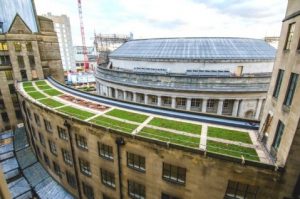
Building Surveying
December 21, 2020
What is Resource Utilization and How Does It Work | A Practical Example
December 21, 2020SECTION 1:
Explain, With Reference To Relevant Statutes And Policies, How The Legislative Framework Operates To Ensure That The Historic Significance And Public Value Of The Selected Building Is Maintained.
The government of United Kingdom is very keen towards the protection of cultural assets of the country. The development of a “Listed Building” ideology is a concept that reflects this government concern. Buildings which are on the list by Historic England are those which have special architecture or historic interest. Buildings which are on this statutory list cannot be demolished, extended or changed unless there is a special permission from the local planning authority, which grant this consent after consultation with the central government agency. There is an entire system that ensures the original sanctity of the building on the list. Once a building makes its way to this statutory list, this system came in action to protect the existence and preserve the importance of it. Manchester Town Hall building is on this list with its roots back in 1877. It is a marvel of architect Alfred Waterhouse. Town Hall houses grand ceremonial rooms, one of which is Great Hall decorated by Ford Madox Brown’s Manchester Murals demonstrating the history of Manchester City. Town hall is a symbol of Manchester history and culture. Statues of John Dalton and Barbirolli are placed at its entrance hall. The exterior of the building is a 280 feet clock tower containing Great Abel, the clock bell (Simon & Inman, 2010).
Historic England is a special government body officially designated as Historic Buildings and Monuments Commission for England to protect the historic environment of England. Its core responsibility is to guard the perservance of the listed buildings and ancient monuments as per central and local government advisory. It is patronized by the Department of media, culture and Sport-DCMS. This can be regarded as a prime legislative body that works to ensure the historic significance of listed buildings in United Kingdom. It was officially formed under the National Heritage Act 1983 and after several modifications completed in April 2015 with a new name of English Heritage. Listing the building is a first step towards acknowledging the importance of historical building. Grading system has been developed to categorize them more effectively. There are two kind of grading system, Grade I and Grade II. Grade I are buildings of exceptional interest. Manchester town Hall comes under Grade II as it states “particularly important buildings of more than special interest” (Jenkins, 2015).
Conservation and Modification work to any listed building require certain approvals to ensure that the real asset value is intact. Planning Act 1990 of listed building is a statutory framework with detailed explanation of each and every action that could be done and could not be done to listed buildings. It legally bound the authorities to act as per historic interest to maintain the public property of national significance. Historic buildings due to their old architect need conservation and repair work periodically to keep it safe and attractive for public and tourists. The conservation of the historic structure not only signifies the culture history of the region, but it also has considerable economic benefits. Therefore, historical structures are considered to highly significant assets of the country, and much effort is done at the governmental as well at social level to ensure safety and optimum utilizations of these assets (Bernard, 2003).
Planning for Manchester Town hall, which is the focus of this research, began in 1863; the corporation wanted it to be the superior building in the country that time. Albert Square was chosen to be the place for construction considering its spacious avenue. Construction began on October 26, 1868 and completed in 1877 with 14 million bricks ("Details of facades, Town Hall, Manchester". RIBA - Royal Institute of British Architects). Since its inaugural, the building has not been fully upgraded. In 2014, The Manchester City Council shared a report that showed an agreement after thorough consideration of all the aspects to refurbish the town hall building. Heating and electrical system, along with windows, stone work and roofs require maintenance and repairing. As per Jeff Smith, Labour councilor of Old Moat ward that the improvements done to town hall will complement its transformation, preserving the historic gems and adding to the services they support. Rigid framework and system established by UK government is solely responsible to keep intact the uniqueness of historic assets and it is doing an exemplary job (Manchester Govt officcial page, 2015).
SECTION 2:
Provide, With Reference To Other Examples Of Historic Buildings, An Informed Explanation Of The Guiding Principles And Philosophies To Be Considered When Undertaking Works Of Conservation.
Works of conservation is regularized by the city council and the local and central government authority under the principle of Planning Act 1990. It cover entire steps starting from the evaluation, requirement, methodology, legal consent, and way work should be done. For the compliance of planning Act 1990, a supplementary planning guidance for Repairs and Alteration to Listed Building was published in 1995, which undergoes periodic revision and updating. The very first step of conservation activity is to seek consent for it, which is referred as “Listed Building Consent” under Planning Act. Listed building control is a special kind of planning control which has the duty to protect a building with historical and architectural importance. This is ahead of any other planning regulations that apply generally, as indicated by pplanning and licensing guide UK Government, repairs and alterations to listed building, 2015 and manchester town hall complex transformation programme, 2014).
The most vivid reason to form such a control is
“To prevent the unrestricted demolition, alteration or extension of a listed building without the express consent of the local planning authority or the Secretary of State”, as per 7th section of the Planning
(Listed Building and Conservation Areas, Act 1990, LBCA Act).
According to these regulations, executions of any works related any modifications, alterations, demolitions and/or extensions cannot be undertaken unless comprehended / approved by the regularity authority. This is to ensure that the historic interest, architectural relevance (outline, design etc.) and the overall character of the building (such as historic materials, timber, frames etc.) is not affected. According to the 1990 Act section 9, violation of this regulations can result in guilty of an offense. During any conservations, the primary aim of the engineers and the constructors is to ensure that original fabric is preserved as much as possible, and the materials compatible with the historic fabric is utilized only for the modification / repair / maintenance works. The FENSA Building Regulations part L details such practices in detail, and can be referred to gain further information on how an optimum balance can be maintained between the building conservation and the proposed alterations.
The city council assesses the application for conservation activity of any listed building based on some established factors under PPG 15 that caters general physical attributes of listed buildings including its material, design, location, its historic and cultural importance, consequent benefits on economy and to public interest and services. There are many examples in history where this system has taken lead and restored the historical assets. In 1989, the original 18th century paneling was removed unauthorized from the Paneled interior to first floor room at 67 Dean Street Soho. A fine of £14,000 was imposed in prosecution and panel was reinstated. The Royal Institution, Albemarle Street, Mayfair is listed as Grade I building. It was repaired in 1995. Extreme caution was taken into consideration to retain the originality. The original material was used and it was painted in imitation of natural stone. The methodology adopted for this repair work was developed in consultation with English Heritage (Bernard, 2003).
Once the application for consent with all the requisites is sent, the processing of application begins. Each city council has design officers with expertise in historic buildings. Consent applications are dealt by them, who review it critically, visit the place and evaluate the credentials and prepare an advisory report against the proposed application. The next phase is consultation with all the concerned authorities including English Heritage, National and local amenity societies and other relevant bodies.
The report is then evaluated for special procedures against The Ecclesiastical Exemption (Listed Buildings and Conservation Areas) Order 1994. Application is assessed against article DES 8 of Planning Act 1990 that demands clear understanding of the material of construction to be used and explicit nature of conservation work to be carried out. It requires stated details for every alteration, repair, extension and preservation. After thorough review, a decision is made. It normally takes six to eight weeks to reach at a decision for an appropriate application. According to Planning (Listed Buildings and Conservation Areas) Act 1990, no conservation act can be done without going through this scrutiny and series of steps
SECTION 3:
With Reference To Relevant Conservation Principles And Philosophies, And Appropriate Conservation Technologies, Evaluate The Work Undertaken To The Selected Building.
The selected building is Manchester Town Hall. It was designed in 13th century in Gothic style but was very innovative as it had air heating system and fourteen million bricks arranged in Spinkwell stone. In the 2010, a process was initiated to repair the Manchester Town hall for its electrical and heating system, along with roof and windows repairing. A conservative approach was planned to be used for preservation of as much original fabric as possible, therefore much considerations were given to the planning aspect if the proposed alterations
Alongside, the proposal of refurbishment and expansion was in consideration. An entirely new technique was employed to get this conservation work done. Building Information Modeling (BIM) was new to Manchester City Council but they wanted the best things to be done for this grandeur asset. This town Hall extension is located in the center of the city and a grade II* listed building. Its architecture is known to be the best of its time and exquisite and innovative for its genre. The refurbishment was began in September 2010 and completed in March 2014. The project included the redesign of town hall extension and central library and cost around £100m (Mallett, 2015).
After the approval from the authorized bodies for refurbishment, the following were marked as the core objectives by the Manchester City Council:
- Modify the building energy system to enhance and optimize the operational performance of heating, cooling and power system of the entire building; to enhance the sustainability aspect of the structure
- Enhance the control of building energy management system
- The BS 5454 conditioned archive spaces within central library archive areas
- Meet Energy saving targets to ensure carbon/energy savings.
The work was completed by a new BIM technique, which was a flagship project not only for UK but internationally. It was so unique in its module that it gave the Council utmost confidence that the building is respected and a series of planned and well informed decisions resulted in very few alterations and restored the originality. Refurbishment of town hall extension and central library using right-first time approach saved a significant amount of cost and time. English Heritage and stakeholder consultants were constantly kept in loop and were informed of project timeline and progress. Manchester City Council’s operational team was actively a part of all the decisions and supervised the asset information system focusing on the mechanical and electrical data for the building. The BIM technology enabled to evaluate the isolated systems of chilled water and power and heating system and added efficiency to the restoration work (Robert Mallett, 2015).

Figure 1: Manchester Town Hall central Library

Figure 2: Town Hall Extension and Central Library Model
This technique made this refurbishment center of attraction for the stakeholders. This not only made town hall a historic icon but a green building of Manchester. A system has been installed that monitors the energy consumption of entire building in terms of heat, light and power at 30 min interval and plot this data to spreadsheet that correlated this consumption to the actual cost. This tool was very effective in gauging the savings and making the building greener. The work completed for town hall extension and central library earn reward for its stakeholders and emerged as an exemplary project in restoration of historic building.
The advantages that are obtained by the application of BIM with respect to appropriate conservation technologies on this historical architecture are as follows (Mallett, 2015):
- Complex interpolation into existing structure creating interactive demonstration of sequencing and methodology for stakeholders. This developed clear understanding of the work to be completed among all the participating teams, outline clear objectives, aims, methods / techniques to be adopted, and activity planning etc. This enables the teams to transfer critical information regarding the structure and ensure that conservation is undertaken as per the requirements of the project.
- Implementation of various design options into a 3D environment using collaborative team of client, contractor and consultant. This facilitated the stakeholders to review / analyze different options / methods of conservations and compare the different techniques; enabling them to select the most appropriate (cost effective as well productive) design and method of conservation.
- Integration of the data into a computer aided system, to analyze all the structural elements of the buildings. This enabled the stakeholder to precisely review the requirements of the building in terms of the changes required, materials to be procured, generate bills of quantities, and in ensuring that the required materials are fabricated as per the original fabric requirements of the structure. It also ensured that offsite manufacturing of geometrical elements are exported to its primary design model
- Ongoing project management using transferring of construction data to the client FM team. This ensured that the facilities management team can obtain critical information regarding the complex at any time with high precision. This enable the facilities teams to maintain the building at the required level, sand undertake optimization as well as periodic repair and maintenance works as per their requirement
SECTION 4:
Evaluate The Current Use Of The Building, And, From A Conservation Perspective, Critically Review Alternative Options For Its Use.
Town Hall is a tourist attraction. There is a Sculpture Hall to the right of the Hall’s main entrance and has statues of notables. As stated by Sir John,
“Amongst the statues are those of conductor Sir Charles Hallé; Anti-corn Law League campaigners, Richard Cobden and John Bright and the remarkable triptych of celebrated Hallé Orchestra conductor”
(Sir John Barbirolli)
The current structure has two floors connected with grand staircase. Second floor of the town hall has some grand halls and staterooms including The Lord Mayor's Parlor, The Reception Room, The Banqueting Room, The Conference Hall and The Great Hall. Once council meetings were held there but now Town hall extension is used for this purpose while these halls are now licensed for wedding events and conferences. The external clock tour tours are arranged for tourists by external tourist organizations. The clock tower is the sixth tallest building in Manchester. Town Hall and Town hall extension hold sanctity for this city. It is a hub of administrative offices that accommodates 3500 working staff that offer direct public service. It is not only a symbol of civic pride but also an emblem of the existence of Manchester City Council. It is also used as a location for television shows and films. There used to be a police station back in 1937 which was reopened in 2014 for public service, unlike traditional police station with custody cells it only facilities the interviews and administrative tasks (Codinhoto et al., 2013).
After the refurbishment of town hall extension, there is a huge shift in the usage of town hall. Manchester Town Hall itself is a Grade I listed landmark of global importance and is praised for its extraordinary architecture. Town hall extension and central library has gone through a historic refurbishment that had changed the way the people look up to the services of city council. But it didn’t do any good to the Town Hall. A recent report has been published that demand the up gradation of Electrical and mechanical system of the building along with repairs to the texture. It was assessed that building need to undergoes maintenance to ensure safety.
Waterhouse's plan for the town hall bridged the gap between ceremonial and office requirements and increased the space on its triangular site. Moreover the ground-floor Sculpture Hall comprises of statues and sculptures of people who are regarded significant towards the development of Manchester. The landing area comprises of glazed skylight on which the names of lords, mayors, and chairs of the council are inscribed on glass panes since Manchester received its Charter of Corporation in 1838 (Codinhoto et al., 2013).
The alterations to the applied changes made to the building were to homogenize the entire setup. All modifications that have been applied to town hall exterior should be done for the town hall and extension in museum should be done. As per Planning Act 1990’s article DES 8, the listed building conservation should be done to preserve its historic significance, and should be best used for what it’s constructed for. After the town hall refurbishment it is licensed for weddings and other such events as well, and it should be restrained to its core purpose.
Overall it is evident that BIM proved its value in terms of project as well as all facilities management, and all the objectives which were necessary for making the delivery of services economical, productive and well-organized in less space were successfully achieved. Allowing BIM as the foundation model for the project during design, specification, construction, operation and maintenance proved its value by retaining the structural importance while ensuring it is utilized in the most productive manner. Therefore, it recommended that the building use in its current state is viable, hence any major / significant alternate use may not be considered in this case. Only the facilities management must be focused in a way to facilitate the community is the most effective way, and utilize the complete complex for all the purposes that been accommodated in its latest conservation.
References
- com, 2014. Manchester Town Hall Complex Transformation Programme. [Online] Available at: http://www.aecom.com/projects/manchester-town-hall-complex-transformation-programme/ [Accessed 2 February 2016].
- CO.UK, 2014. Manchester town hall: refurbishment planned by council. [Online] Available at: http://www.bbc.co.uk/news/uk-england-manchester-29448396 [Accessed 2 February 2016].
- Bernard, F., 2003. Conservation of Historic Buildings, Third Edition (Conservation of Historic Buildings). Architectural Press: July 2003
- Codinhoto, R., Kiviniemi, A. & Kemmer, S., 2013. Research Report: Manchester Town Hall Complex. Manchester: Ubon Martin Essiet, Vincenzo Donato, Lais Guerle Tonso University of Salford, Manchester.
- Jenkins, S., 2015. The secret negotiations to restore Manchester to greatness. [Online] Available at: http://www.theguardian.com/uk-news/2015/feb/12/secret-negotiations-restore-manchester-greatness [Accessed 2 February 2016].
- Kiviniemi, A., Codinhoto, R. & Kemmer, S., 2011. BIM Implementation: Manchester Town Hall Complex. [Online] Available at: https://www.researchgate.net/publication/260190471_BIM_Implementation_Manchester_Town_Hall_Complex [Accessed 2 February 2015].
- gov.uk, 2015. Planning (Listed Buildings and Conservation Areas) Act 1990. [Online] Available at: http://www.legislation.gov.uk/ukpga/1990/9/contents [Accessed 2 February 2016].
- Mallett, R., 2015. Manchester Town Hall Complex & BIM: reaping the benefits. [Online] Available at: http://www.rics.org/us/footer/bim-solutions/manchester-town-hall-complex/manchester-town-hall-complex---part-3/ [Accessed 2 February 2016].
- gov.uk, 2015. A History of Manchester Town Hall. [Online] Available at: http://www.manchester.gov.uk/info/500211/town_hall_complex/1986/a_history_of_manchester_town_hall [Accessed 2 February 2016].
- Planning and licensing guide UK Government, 2015. Repairs and Alterations to Listed Building. Supplementary Planning Guidance. Online: http://www.westminster.gov.uk/planningandlicensing/udp/index.cfm/>. Accessed [28 January 2016].
- Robert Mallett, R., 2015. Manchester Town Hall Complex & BIM: the future city. [Online] Available at: http://www.rics.org/ru/footer/bim-solutions/manchester-town-hall-complex/restoring-civic-pride---manchester-town-hall/ [Accessed 2 February 2016].
- Rose, A.E., 209. Listed Buildings and Conservation Area Act 1990. [Online] Available at: http://www.planningportal.gov.uk/uploads/1app/guidance/guidance_note-listed_building_consent.pdf [Accessed 2 February 2016].
- Simon, E.D. & Inman, J., 2010. The Rebuilding of Manchester. Longmans, Green.




















